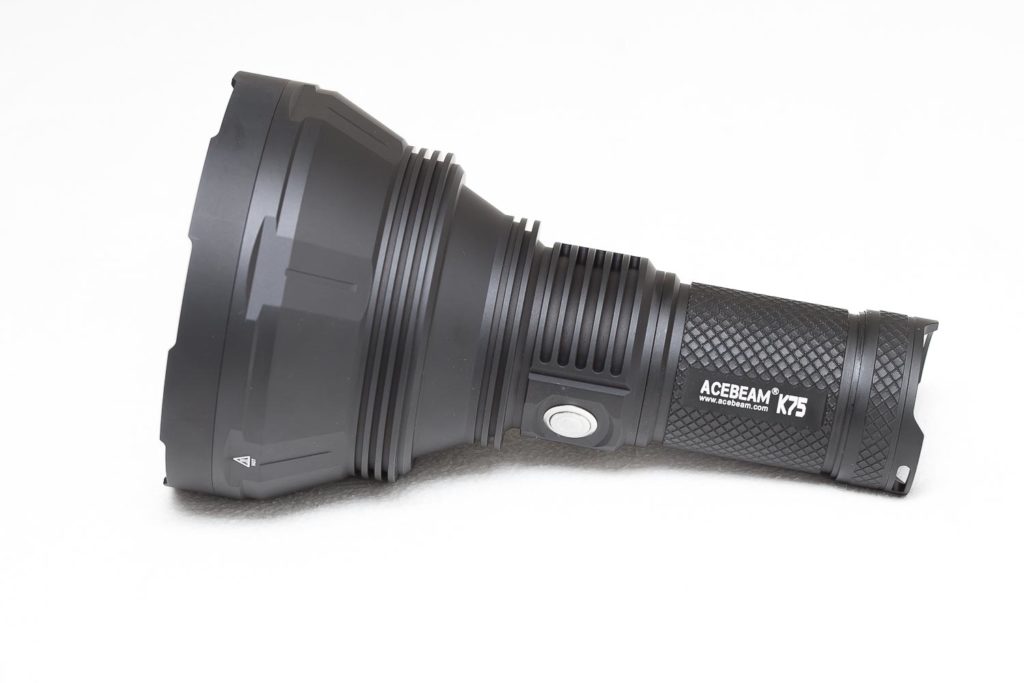Acebeam K75 review
Acebeam K75 specs
| Brand / Model | Acebeam K75 |
|---|---|
| Category | Throw flashlights |
| LED | Luminus SBT-90 II |
| Max. output | 6,300 lumens |
| Max. beam intensity | 1,562,500 cd |
| Battery config. | 4*18650 |
| Material | Aluminum |
| Modes | 6 |
| Blinkies | 1 |
| Reflector | Smooth |
| Waterproof | IPX68 |
| Review date | November 2019 |
Introduction:
Is Acebeam K75 the next killer thrower? After the BLF GT was surpassed by the Astrolux MF04, we now have Acebeam stepping up its game. And instead of using the CREE XHP35Hi, Acebeam went for the Luminus SBT-90 gen II. It is claimed to throw 2.5 kilometers / 1.5 miles and a maximum output of 6300 lumens.
We will soon know if those claims are true or just a fairy tale.
What you’ll get:
The package quality is good but basic. I’d love to see those aluminum carry cases come back… who knows…
- Acebeam K75
- Handle
- 4*18650 Acebeam batteries
- Lanyard
- Spare O-rings
- Warranty card
- Manual
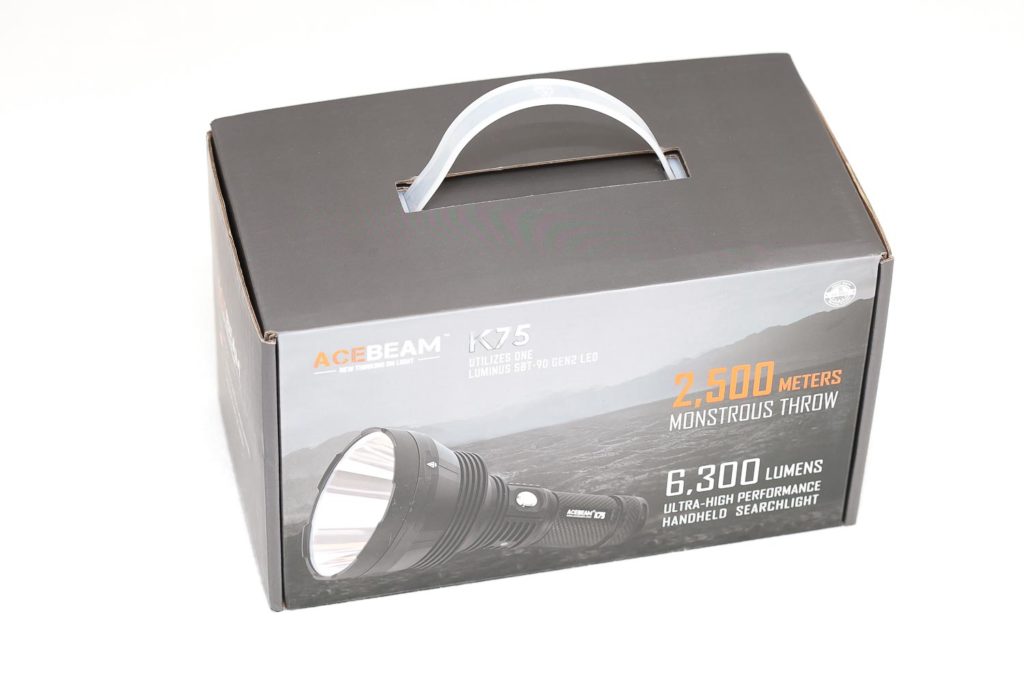
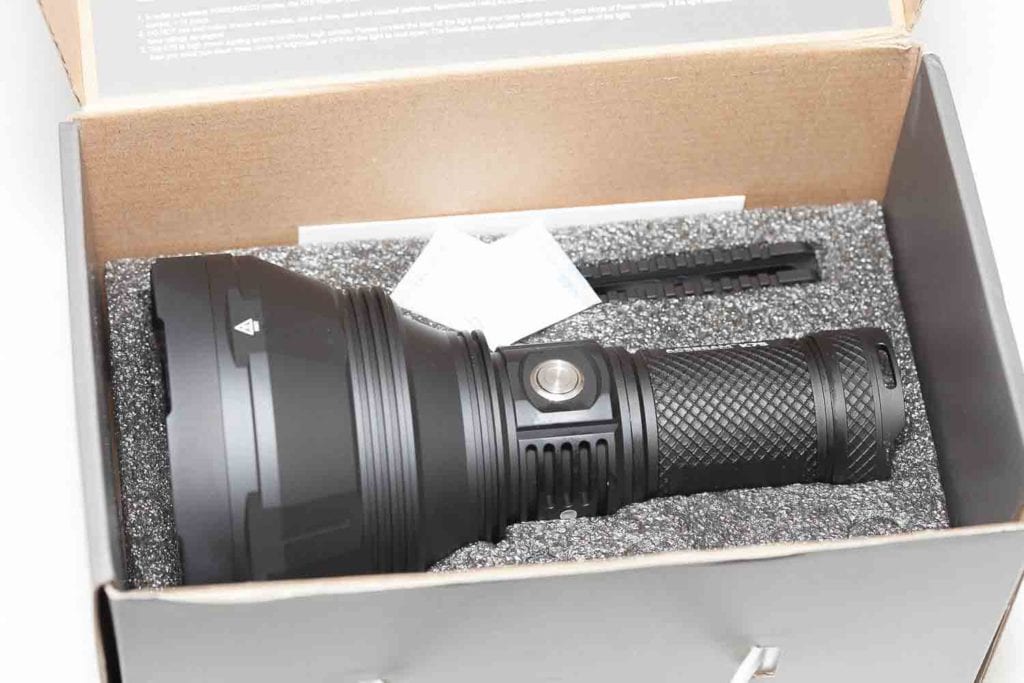
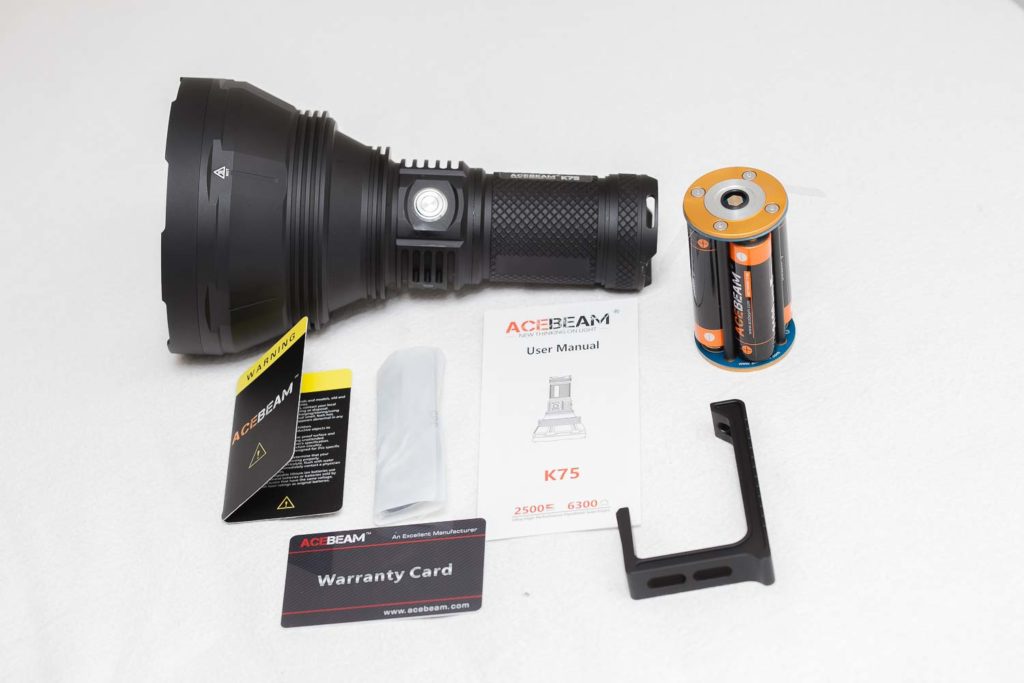
Handling of the light
If you are looking for one of the farthest-reaching LED flashlights in the world, this might be for you! With ‘just’ 4 batteries, the K75 isn’t too wide. For people with smaller hands, you can easily attach the carry handle. This is actually nice since you won’t burn your hands. Lol.
The K75 uses a single switch to power and change modes. When you hold the battery tube and rest your thumb upon the switch, you can feel that it is front-heavy. So the carry handle is not a luxury, but more of a necessity if you are going to hold it for a longer period. This has been my complaint about the BLF GT for example. Since it is so heavy, you have to use the shoulder strap. You can also attach the carry handle to some sort or rails. And I bet Acebeam did some research before they included the handle. Good on them!
If you enjoy carrying a 1+ kilogram flashlight in your hands, you are tough. You could, however, use the lanyard to carry the light around. You know, just to relax those tiny muscles in your wrist.
The battery tube has a great amount of knurling so it isn’t slippery at all. Another great characteristic!
Tail standing:
No problem at all. Keep in mind that tail standing is normally used as a candle replacement. And the K75 isn’t candle-sized.
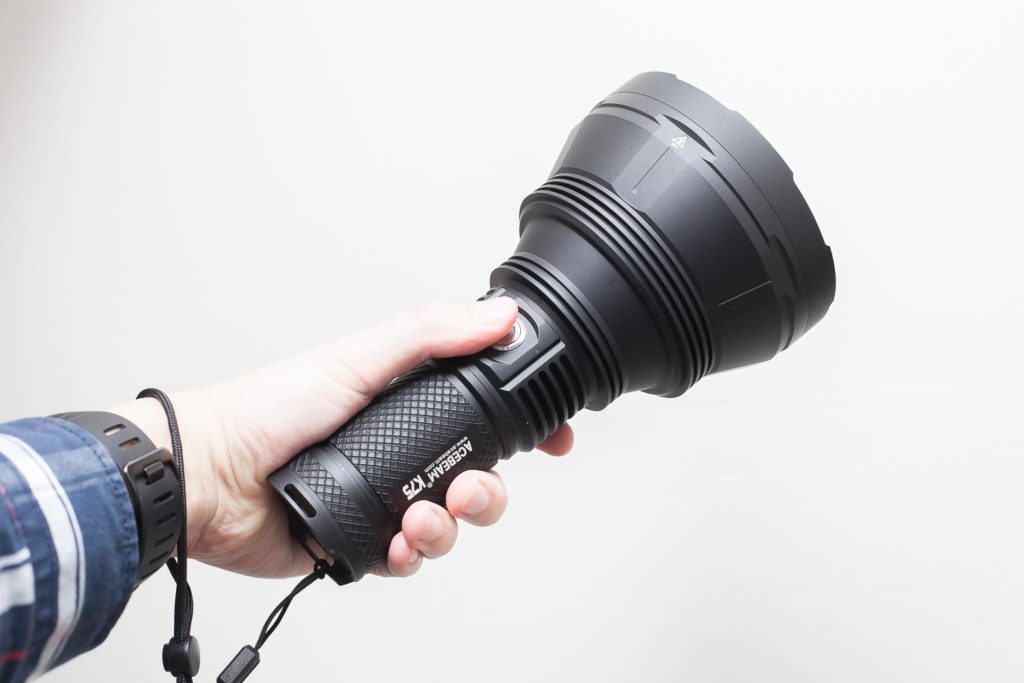
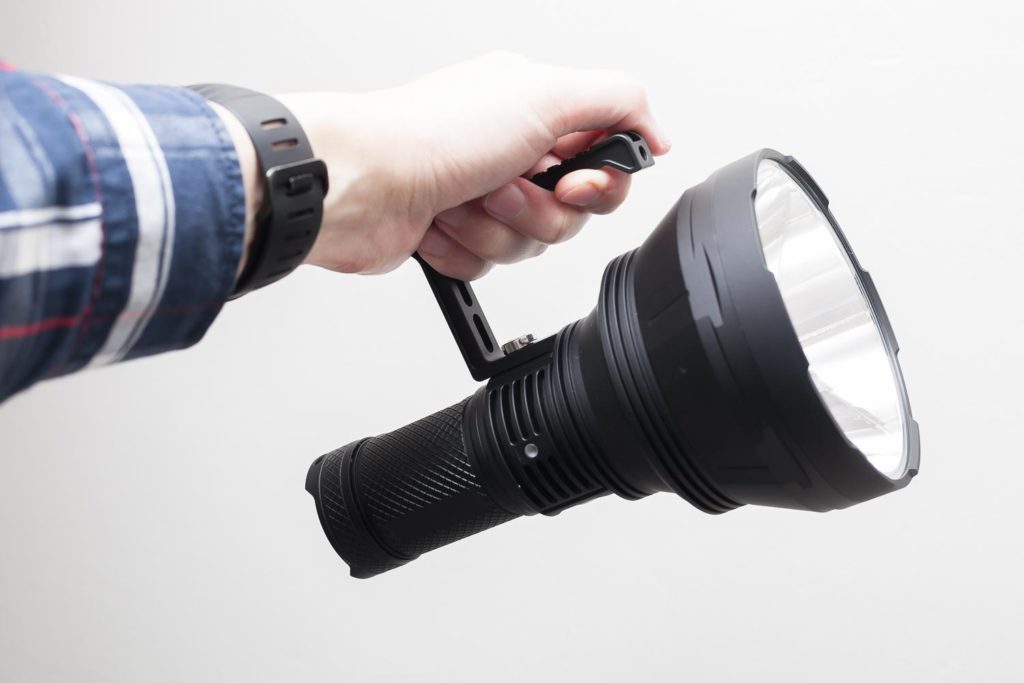
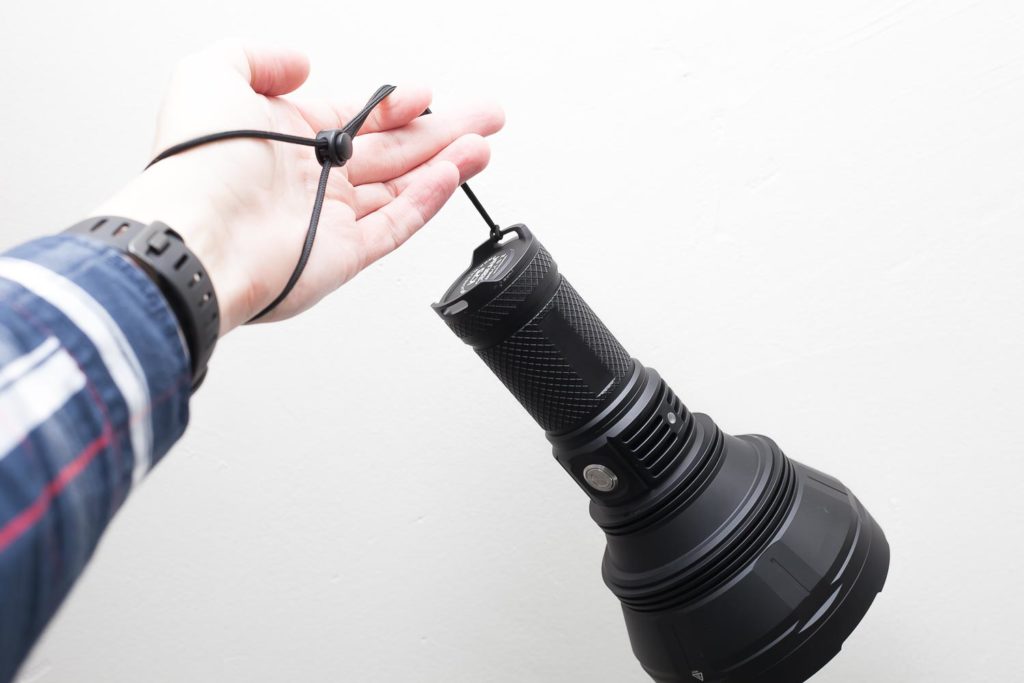
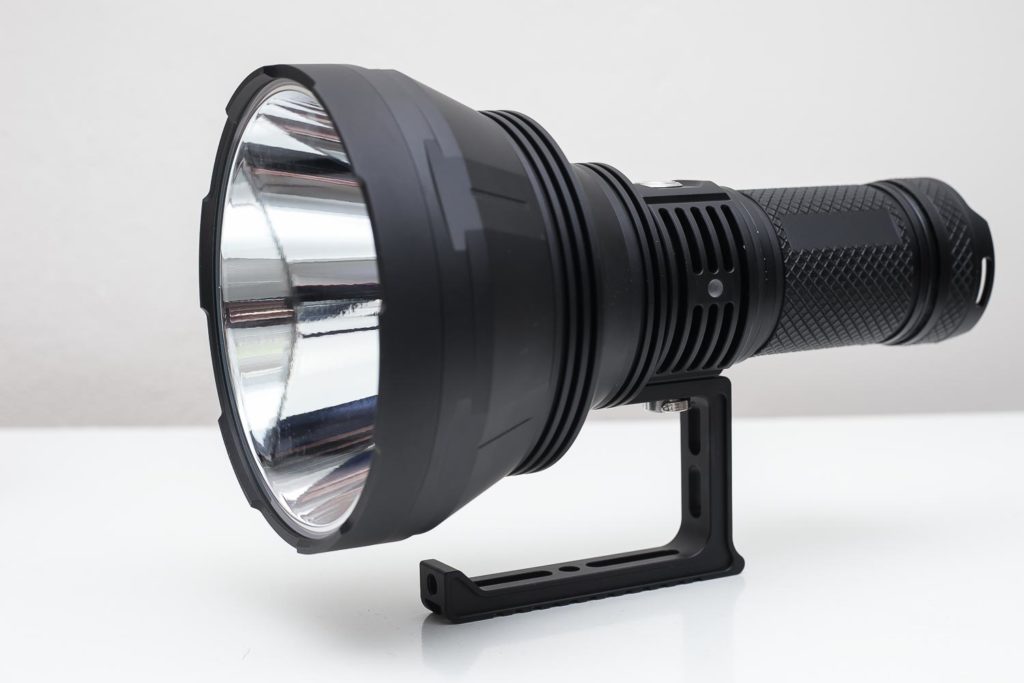
Build Quality, knurling, threads, and anodization
Acebeam produces top-of-the-line flashlights, and the K75 is definitely one of them. All parts match and fit together nicely. Threads are smooth and have enough lubrication. The anodization is matte and a little sensitive to stains, like fingerprints. But in general, the build quality is fantastic.
The handle can be removed by hand, but it’s much easier if you use a coin or piece of metal.
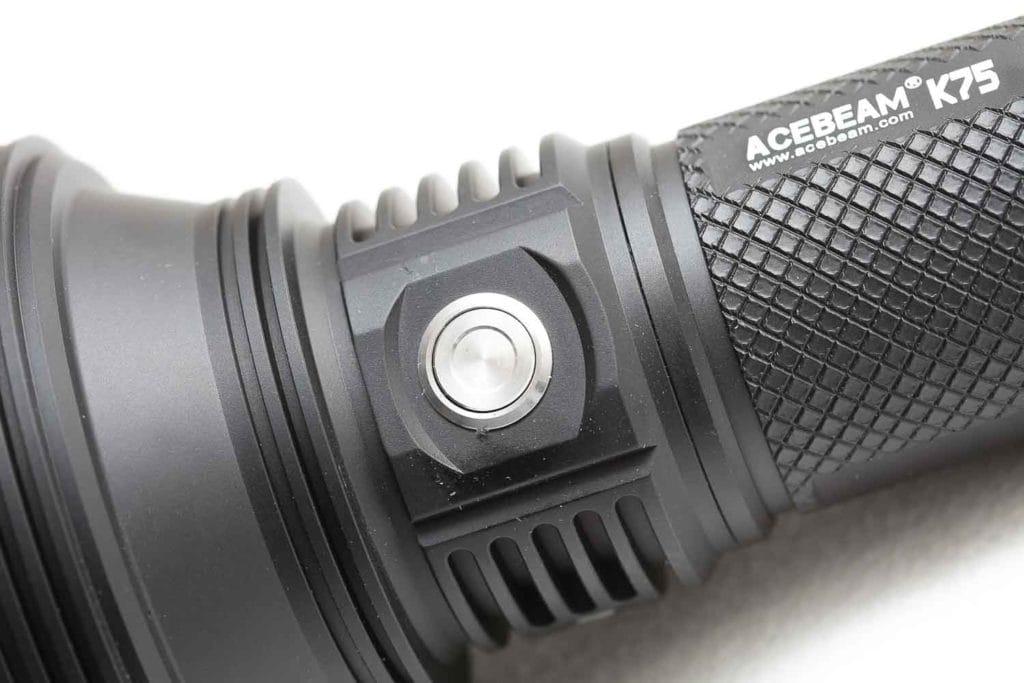
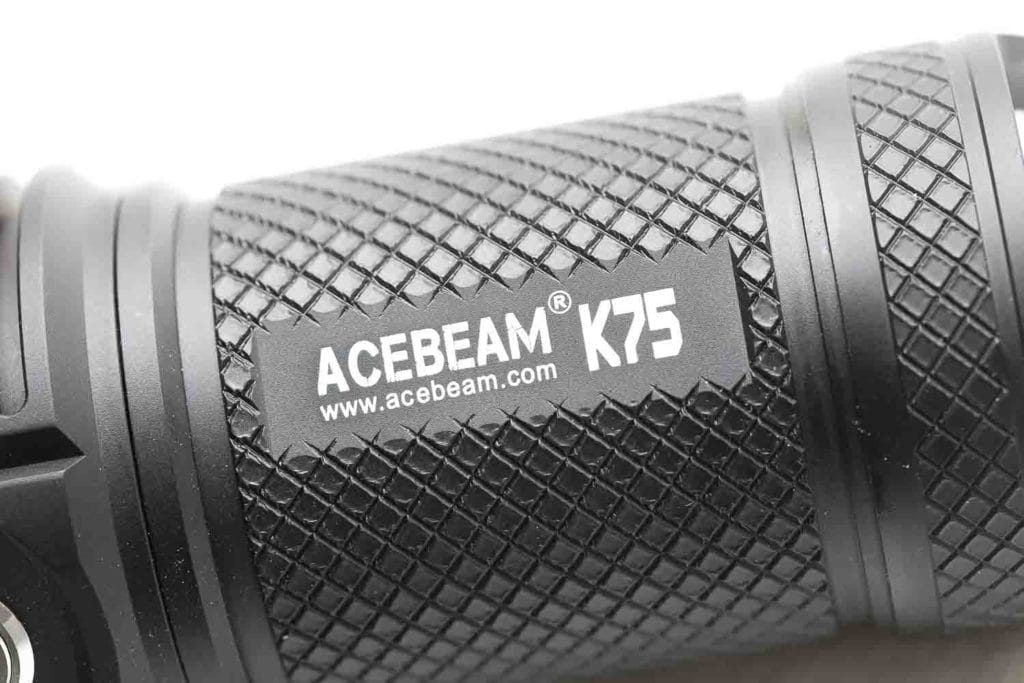
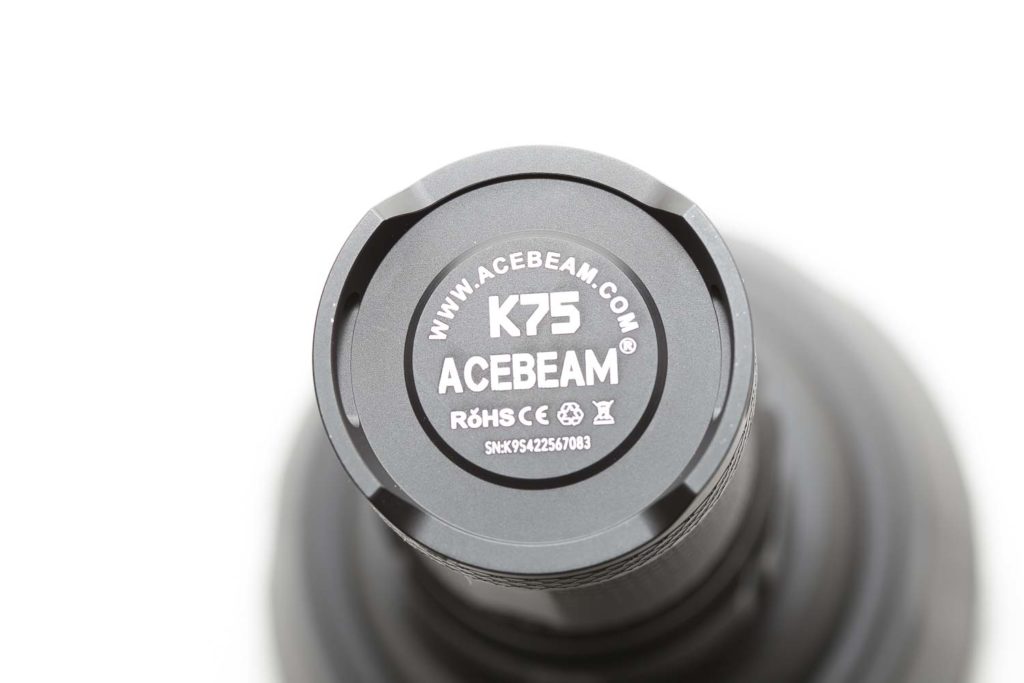
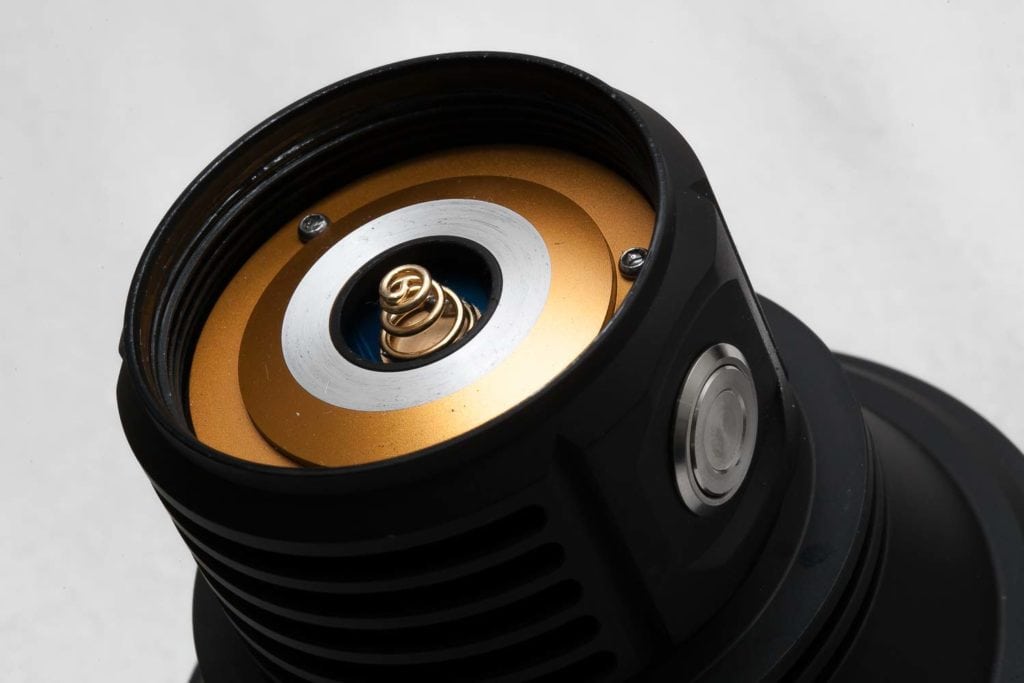
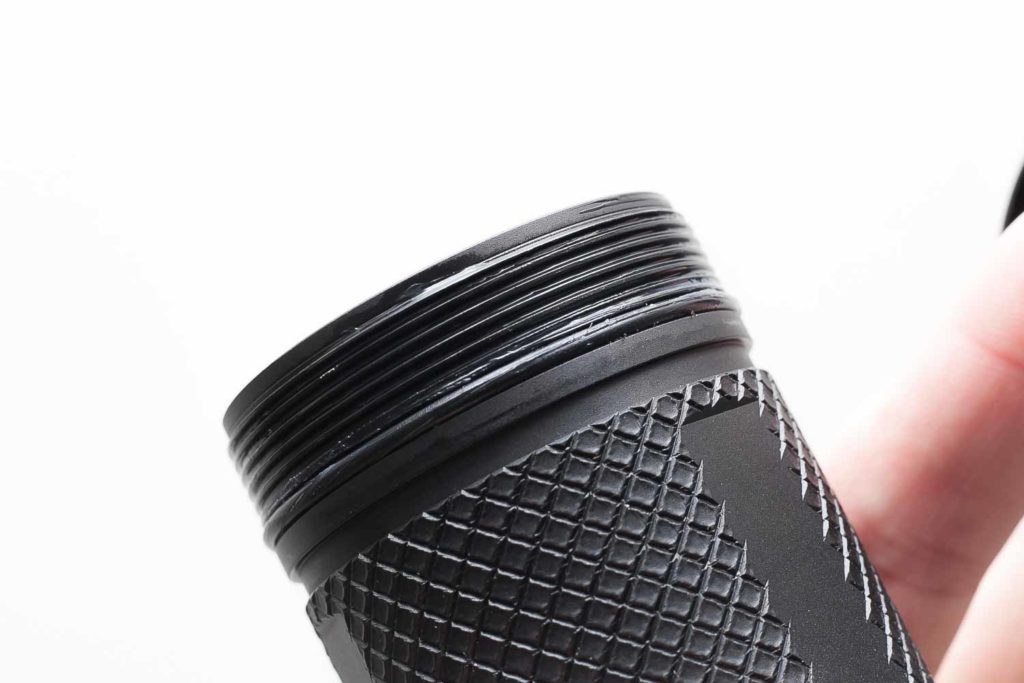
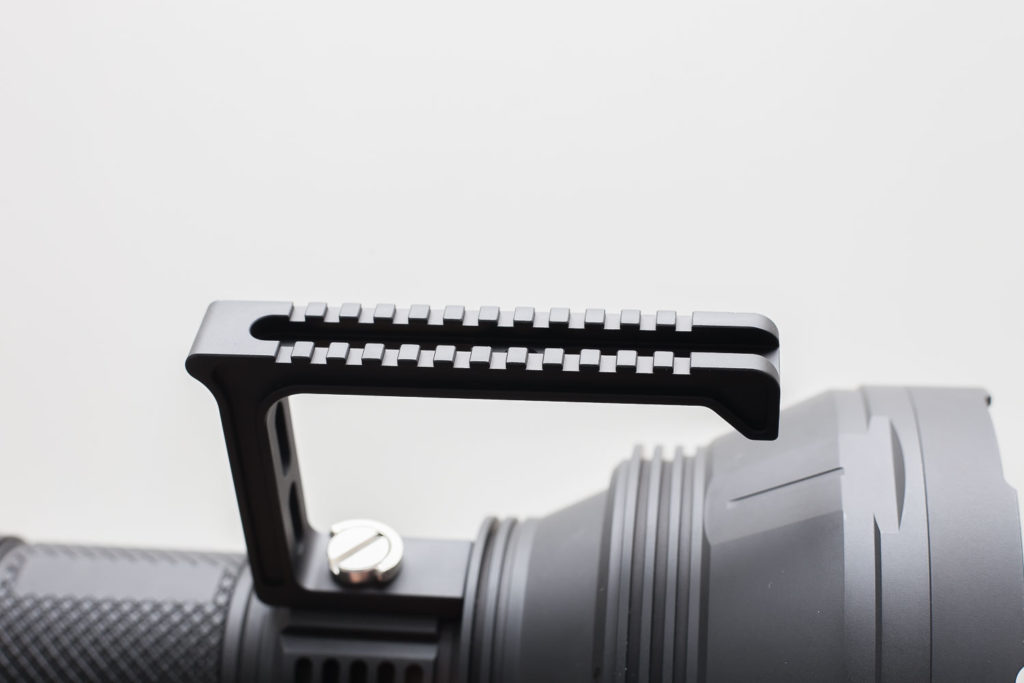
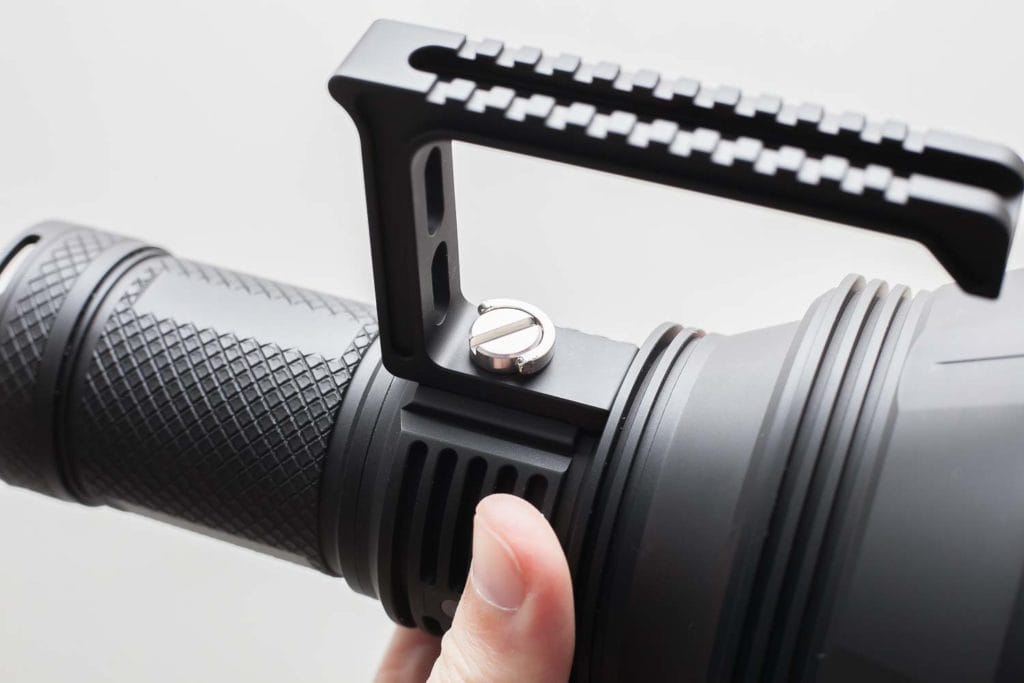
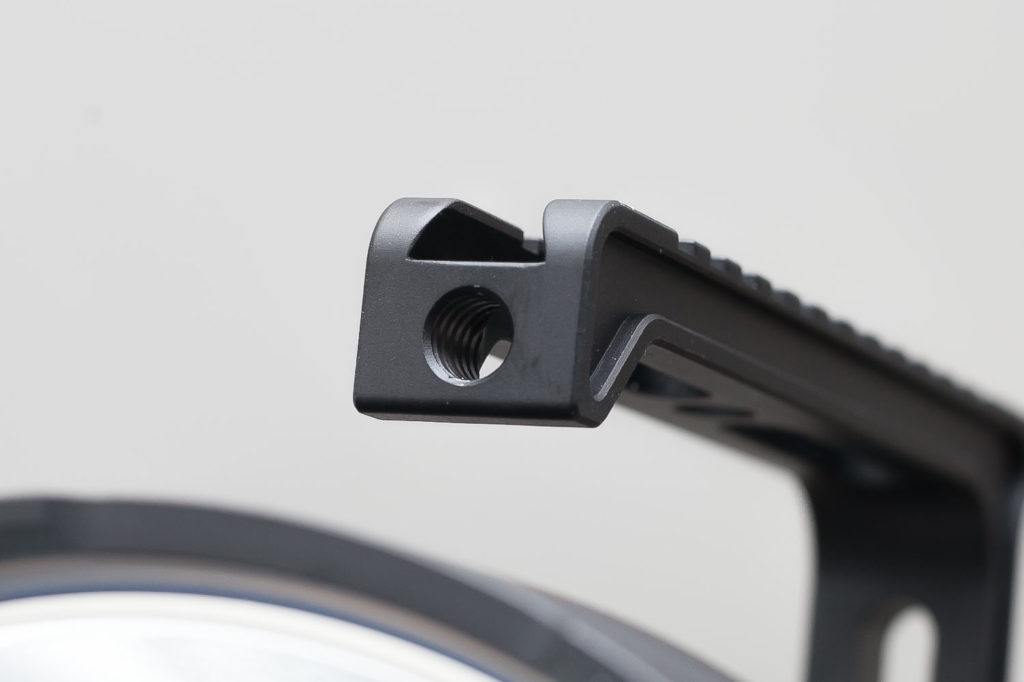
Acebeam K75 LED, Lens, Bezel and Reflector
Luminus SBT-90 II. Here comes the first exciting part. While Lumintop and Astrolux both used the Cree XHP35 LED, Acebeam took another route and instead of copying them, they went with a totally different emitter. The emitter they chose is the Luminus SBT-90 generation 2. This LED can produce not only more lumens but also more throw. I like this a lot about Acebeam. While Astrolux copied Lumintop, Acebeam stepped it up and tried to beat them both at the same time.
In the lowest settings, the beam looks a little greenish. And for the beam shots, we will take this bad boy outside, so we’ll see how it looks outdoors.
The bezel is made of aluminum, just like the body, and the reflector is smooth. But it isn’t as smooth as some other flashlights though. If you look carefully at the next few pictures, you can see that it has a slight orange peel feeling, just very, very slightly.
The last picture shows the reflector next to the Lumintop FW3A.
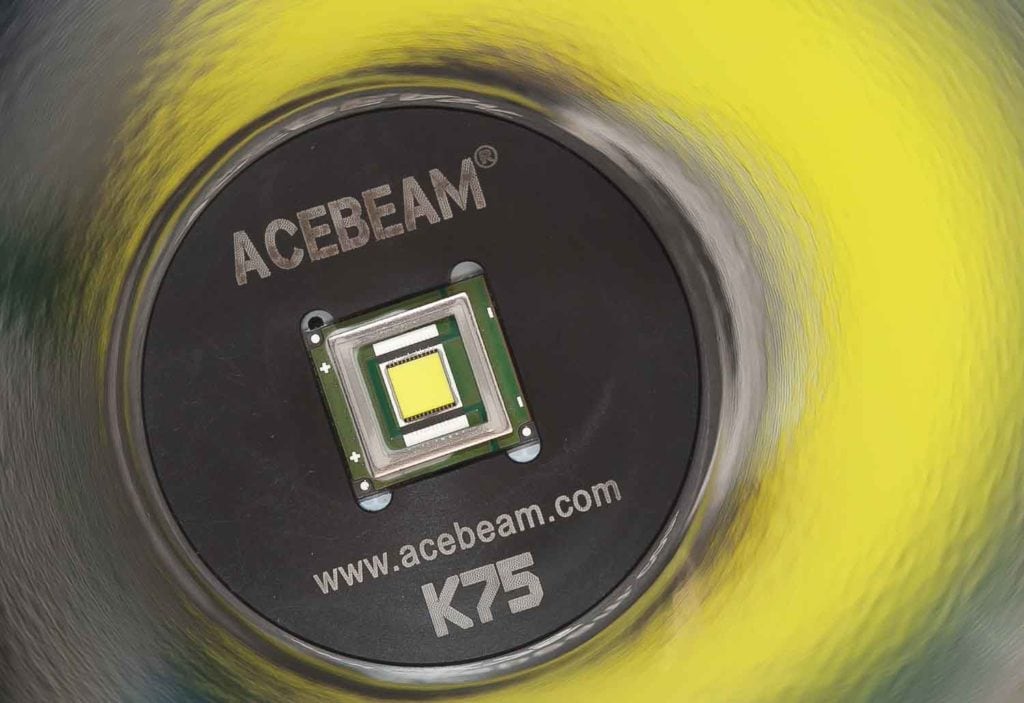
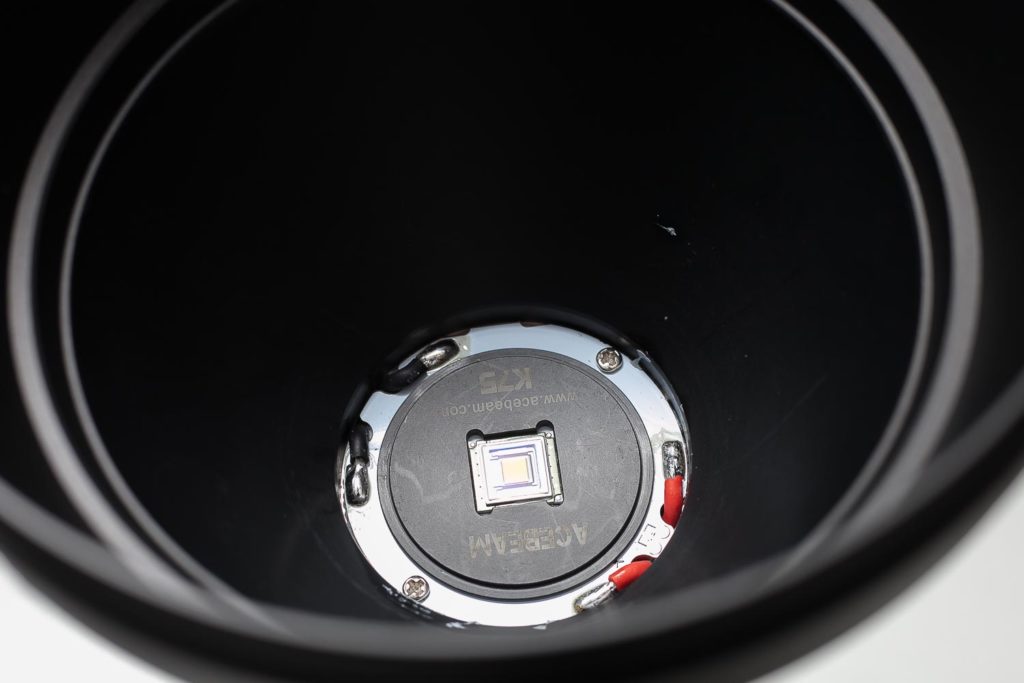
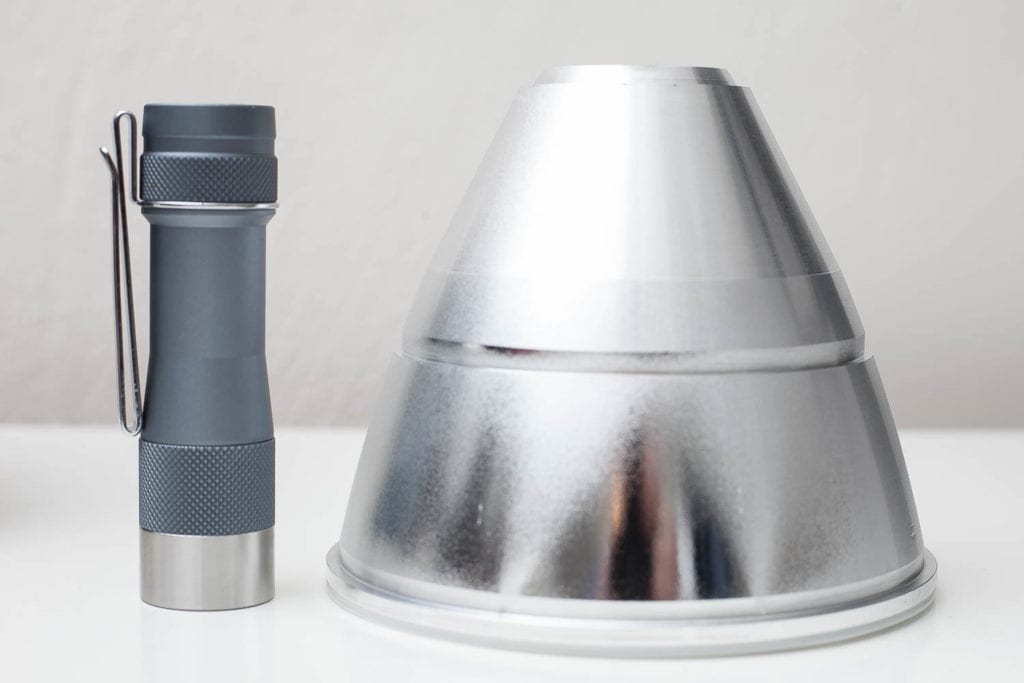
Acebeam K75 dimensions:
- Length: 218 mm
- Head diameter: 126 mm ( 4.97 ”)
- Reflector diameter: 112mm (4.4 “)
- Glass thickness: 4mm
- Body diameter: 50 mm ( 1.97 ”)
Weight:
- With battery and handle: 1136 g ( 40.08 oz)
Powerful flashlight throwers comparison:
Size comparison with other flashlight throwers. From left to right: Acebeam K75 (Luminus SBT-90 II), Astrolux MF04S (Cree XHP70.2) and Lumintop BLF GT (Cree XHP35 Hi).
Compared to these monster throwers, the K75 is rather short.
The bottom picture shows from left to right: Lumintop GT Mini, Astrolux FT03, Acebeam K65, Acebeam K75, Astrolux MF04S, Lumintop BLF GT.
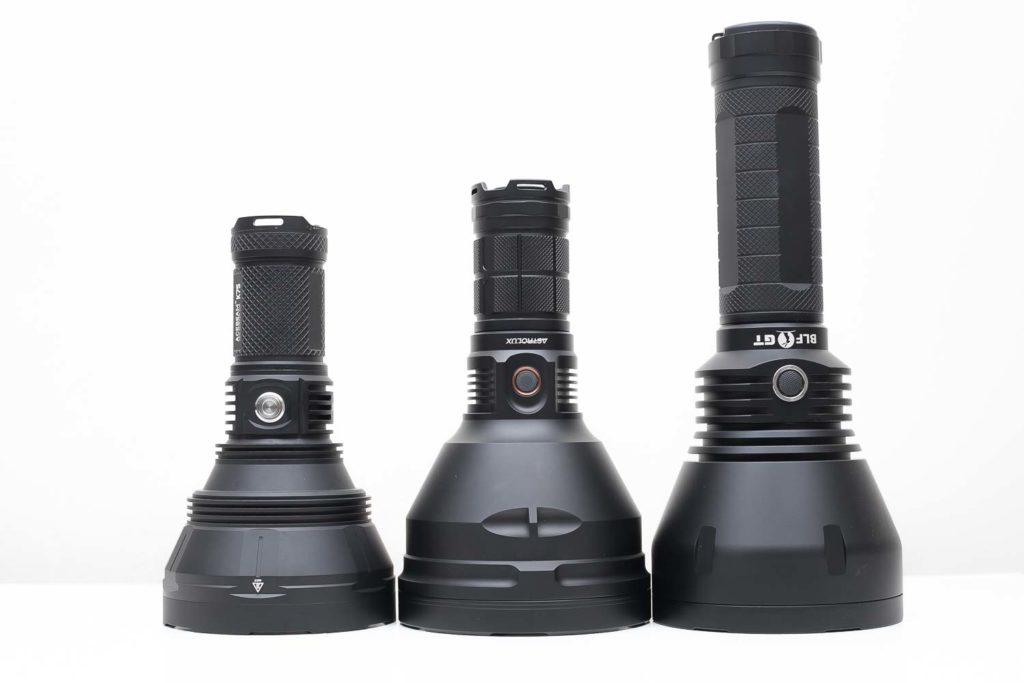
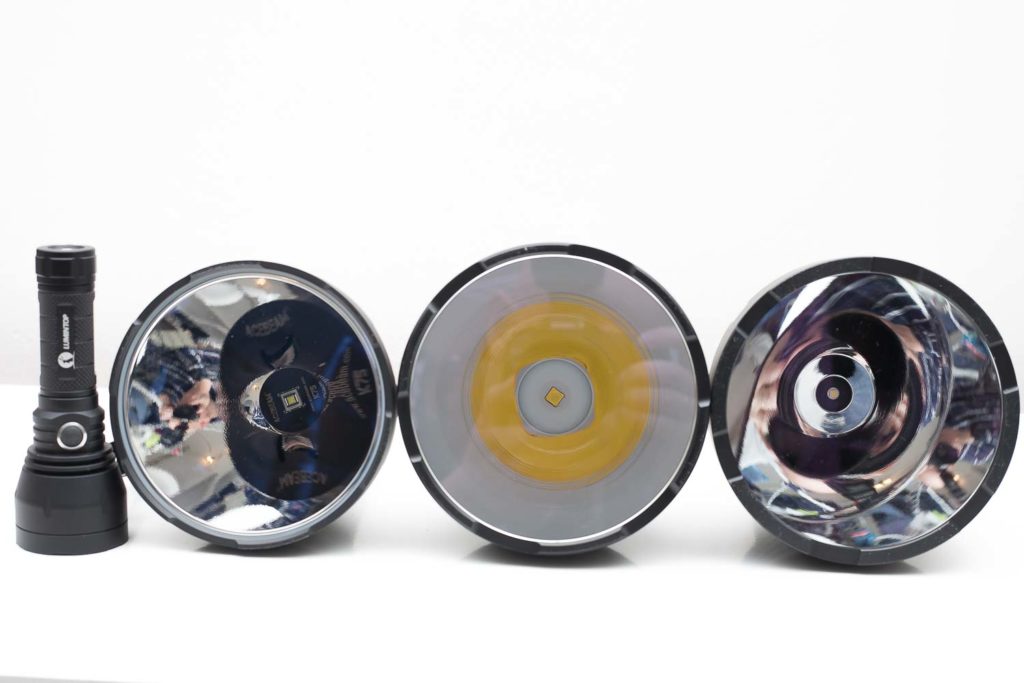
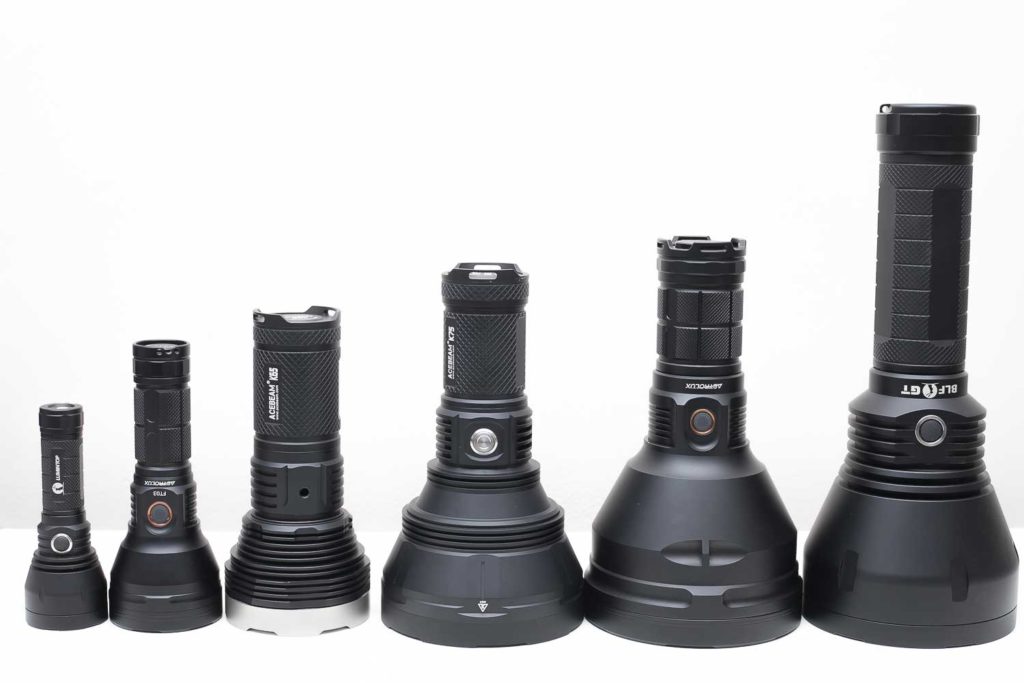
Acebeam K75 UI & Driver
Eco mode and Power mode
This gets a little interesting. While doing my lumen measurement I couldn’t get past 2xxx lumens, so I had to read the manual. Something that men don’t do, right?
I soon figured out that mine must have been in Eco mode. So my first question was:
How to change to Power mode on the Acebeam K75?
The answer wasn’t so straightforward in the manual. I hope to make it a bit easier to understand, here is my try:
- Turn the light OFF
- Press-and-hold for 5 seconds until you see 2 short flashes (you will pass the Ultra Low-mode, so keep pressing, and enter the Lock-out mode)
- Click the switch 10 times, until you see 2 longer blinks. (1 is brighter than the other. If the second is the brightest it means you stepped up from Eco mode to Power mode. If the second blink is dimmer, you went from Power mode to Eco mode.)
- Press and hold for 5 seconds, until you see 2 short flashes (now you deactivated Lock-out mode)
Modes:
- (Ultra-Low) Low, Mid1, Mid2, High (Turbo)
- Ultra low and turbo are not in the standard mode group.
From OFF:
- Single-click: last used mode, mode memory
- Double click: Turbo
- Triple-click: Strobe
- Press and hold 3 seconds: Ultra-Low
- Press and hold 5 seconds: Lock-Out
From ON:
- Single-click: Off
- Double click: Turbo
- Triple-click: Strobe
- Press and hold: Cycle through the menu from Low to High
Blinky modes menu:
- There is only 1 blinky mode and that’s Strobe. Triple-click from either the ON or OFF position.
Low battery warning:
- At 12V (3V per battery) the small LED indicator on the side will start blinking
- At 11.2V the light will turn OFF.
- When I took the batteries out, after running empty, the batteries were at 2.98 resting voltage. This means that they dropped to below 3V under load.
Lock-out mode:
- Press and hold the switch for 5 seconds when OFF
PWM:
- Couldn’t detect any by eye. That’s the most important. I don’t care so much if you can see it with a camera, and not by eye.
Firmware / UI Conclusion:
The UI is simple, but I don’t really see why they chose to have 2 separate Mode Groups (Eco mode and Power mode). The UI is rather straightforward with some shortcuts to Low and Turbo. This makes it easy to understand and great to use! My personal preference is still Clicking for changing modes instead of holding the switch depressed.
Acebeam K75 batteries and charging
Acebeam added 4* 18650 High Amp batteries to the set. Especially with these kinds of lights, you want to have max power, and Acebeam provided good batteries looks like. The K75 doesn’t have a built-in charger, so you need to charge them in a dedicated Lithium-Ion charger. If you own multiple flashlights, you surely have a 18650 charger.
Warning: You can’t use flat top, unprotected batteries! They are too short, and won’t fit.
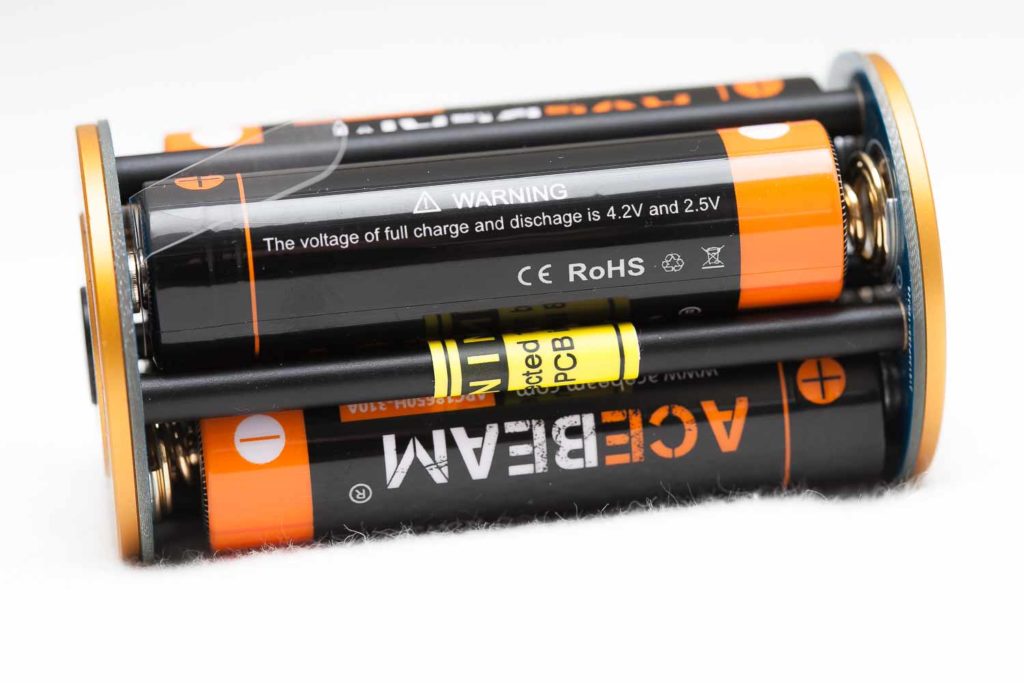
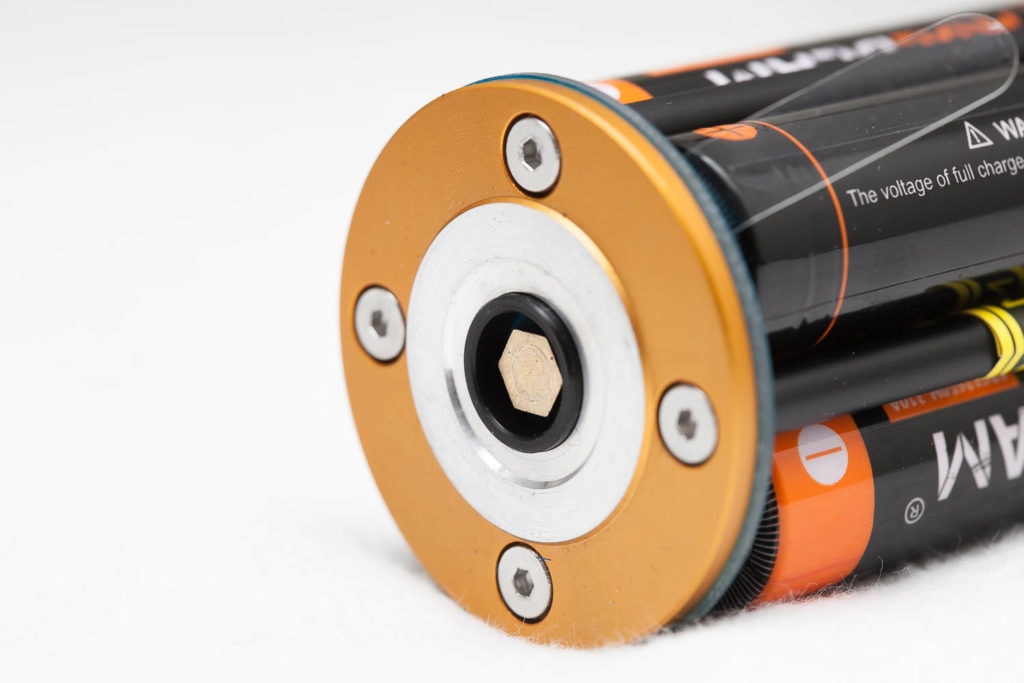
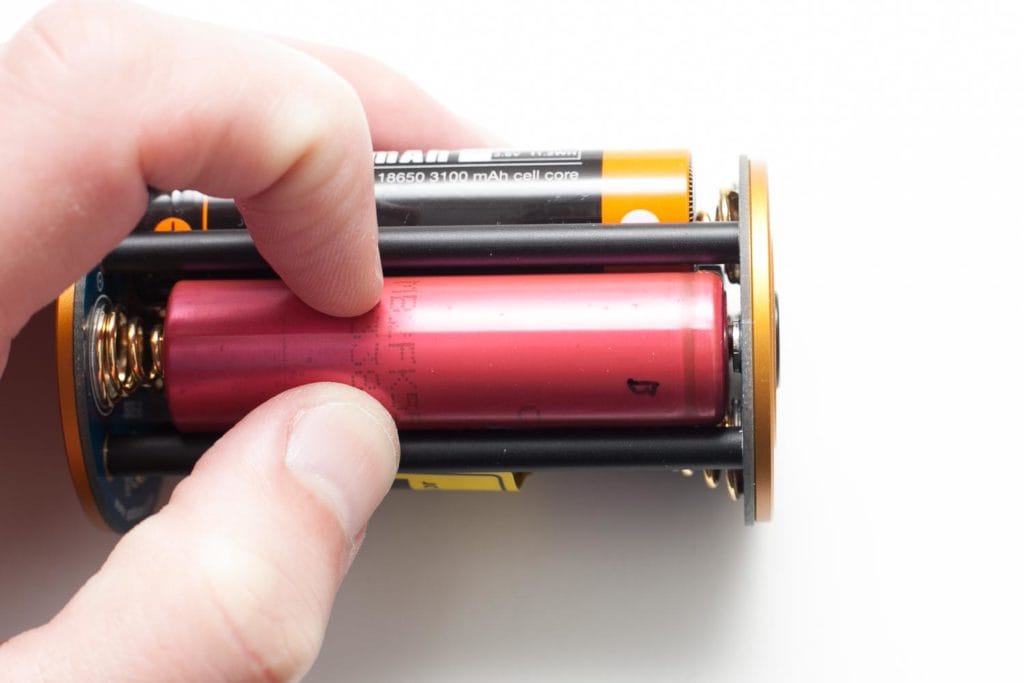
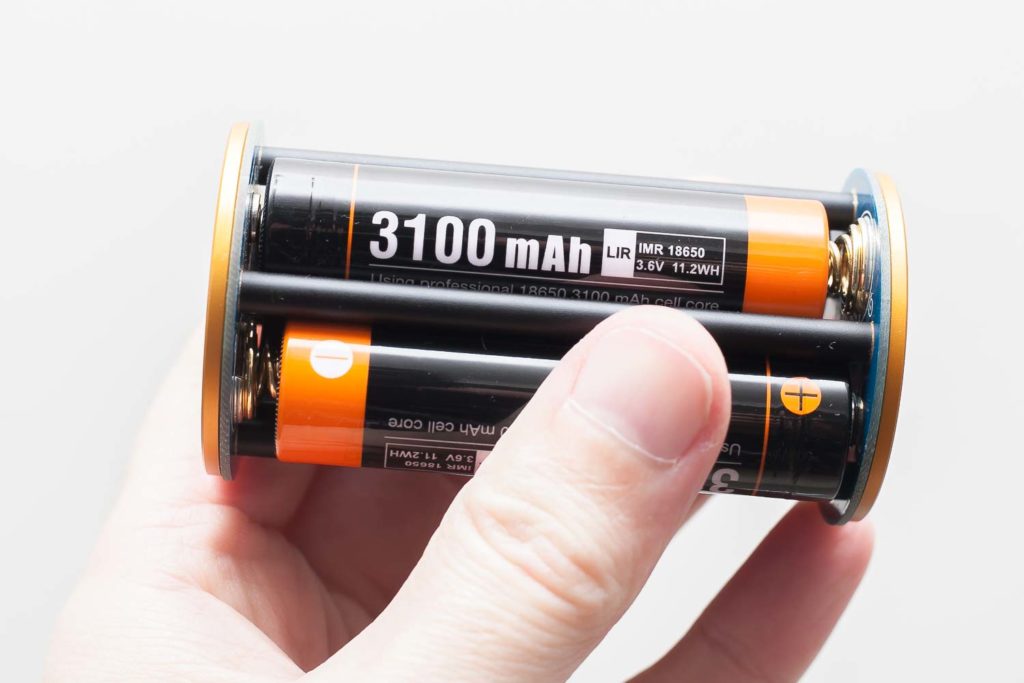
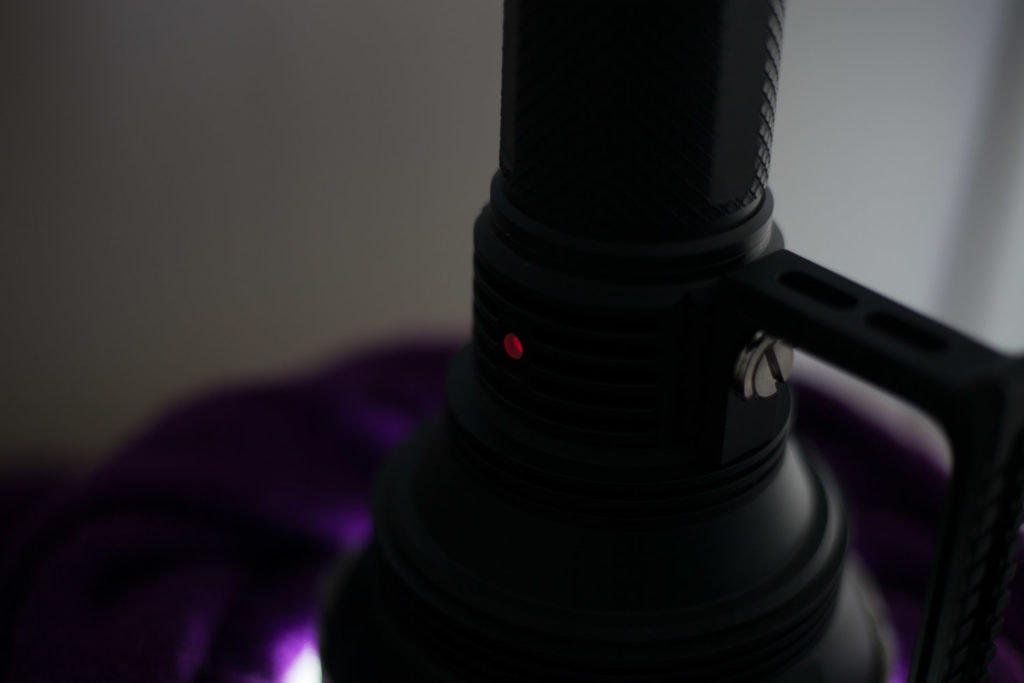
K75 Performance testing
I took all of my readings from fully charged Acebeam batteries. I tested Amps with a Fluke 77III and standard probes and Turbo with short copper wires to eliminate losses over the wire.
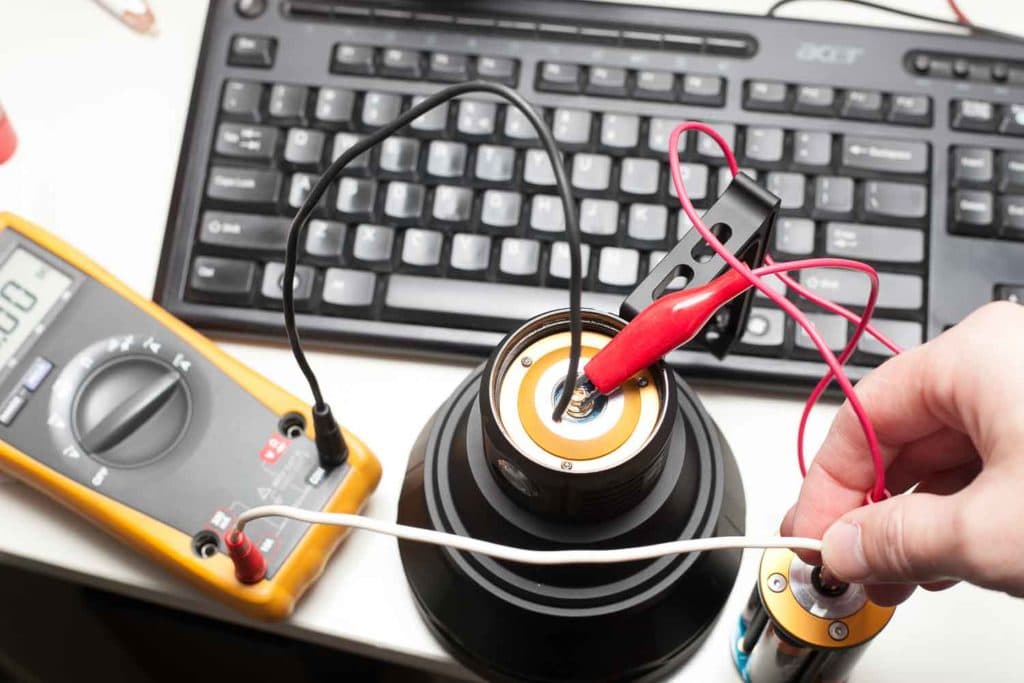
Amp measurement
- Lowest: 0.02A
- Turbo: 9 A
Acebeam K75 lumen measurements:
All output numbers are relative to my home-made Integrating Sphere and was set up with an Extech HD450 Lux Meter for measurements. For bright flashlights (above 5000 lumens) I am adding a Kenko PRO1D ND-16 filter. The base measurement is done with a Convoy S2+ that is tested at 137 lumens.
The problem with doing this is the difference in the opening of the Integrating Sphere. The Convoy S2+ shows different numbers depending on the size of the opening in the Sphere. The K75 uses a much larger opening. So I used the same opening to measure both lights.
Eco Modes:
| Mode | Specified | Measured |
|---|---|---|
| Ultra-Low | 7 lm | 6.16 lm |
| Low | 150 lm | 122 lm |
| Mid1 | 250 lm | 235 lm |
| Mid2 | 600 lm | 574 lm |
| High | 1700 lm | 1559 lm |
| Turbo | 3000 lm | 2711 lm |
Power modes:
| Mode | Specified | I measured: |
|---|---|---|
| Ultra-Low | 7 lm | 5.97 lm |
| Low | 150 lm | 181 lm |
| Mid1 | 380 lm | 347 lm |
| Mid2 | 1,250 lm | 1,131 lm |
| High | 2,500 lm | 2,146 lm |
| Turbo | 6,300 lm | 6,480 lm |
Acebeam K75 battery life / runtime
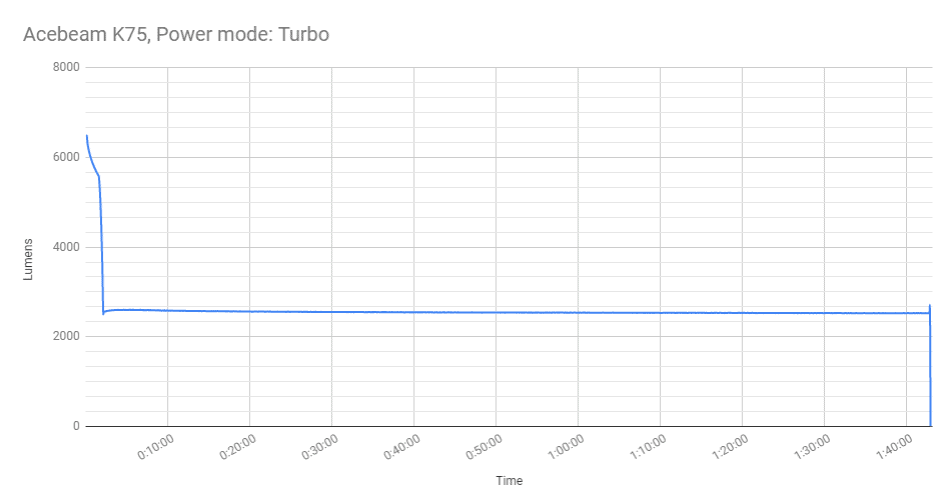
Turbo drops at 2 minutes. From then on there is a stable output of 2500 Lumens till it dies at 1 hour and 43 minutes. Acebeam claims 1 hour and 45 minutes, so this is not far off at all. I will assume that all the other numbers are correct.
| POWER MODE | Turbo | High | Mid2 | Mid1 | Low | Ultra-Low |
| Lumens | 6300 | 2500 | 1250 | 380 | 150 | 7 |
| Runtime | 1h 45m | 2h 15 | 5h 15m | 16h | 27h | 7.5 days |
| ECO MODE | Turbo | High | Mid2 | Mid1 | Low | Ultra-Low |
| Lumens | 3000 | 1700 | 600 | 250 | 150 | 7 |
| Runtime | 1h 45m | 3h 30m | 10h 30min | 21h | 27h | 7.5 days |
There is no real warning, except for the Indicator LED on the side of the body. This started blinking at
Acebeam K75 Throw measurement
I took measurements both indoors and outdoors with the Hagner E4-X. The indoor measurement was strange so I wouldn’t trust the numbers. We should measure far throwers at a minimum of 10-20m distance.
Using the Turbo mode (in POWER MODE) only, I get:
- Indoors (5m): 1675000cd = 2588 m / 1.6 miles of throw
- Outdoors (10m): 1565000cd = 2502 m / 1.55 miles of throw
- Outdoors (20m): 1492000cd = 2443 m / 1.52 miles of throw
This means it outperforms both the Lumintop BLF GT and the Astrolux MF04 by a fair margin. And therefore it is the new king of throw! Congratulations Acebeam, you did it!
Beamshots
For the following beamshots I went outside and compared the best flashlight throwers in the world.
The distance from the tower is about 650 meters. Shot with a 100mm lens, 1600 ISO, f4, 0.5 sec, 5000K
The distance from this tower is about 450 meters.
You can compare the following flashlights:
- Acebeam K75 vs Astrolux MF04
- Acebeam K75 vs Astrolux MF04S
- Acebeam K75 vs Lumintop GT
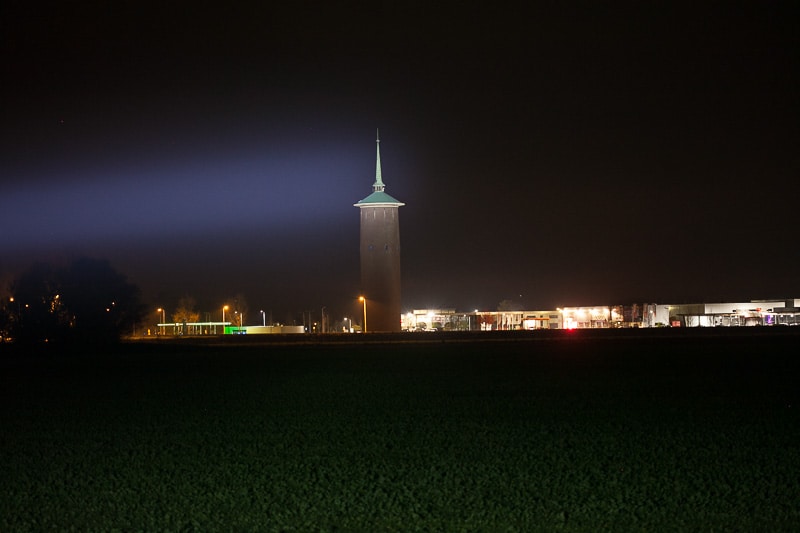
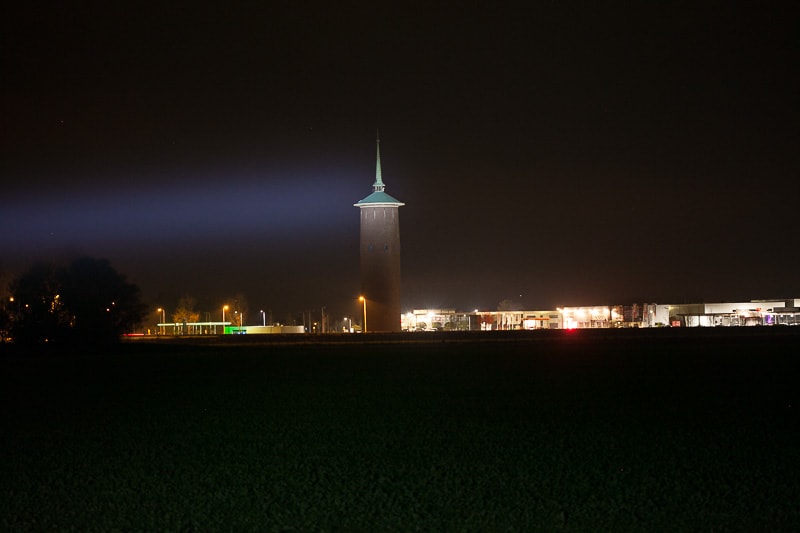
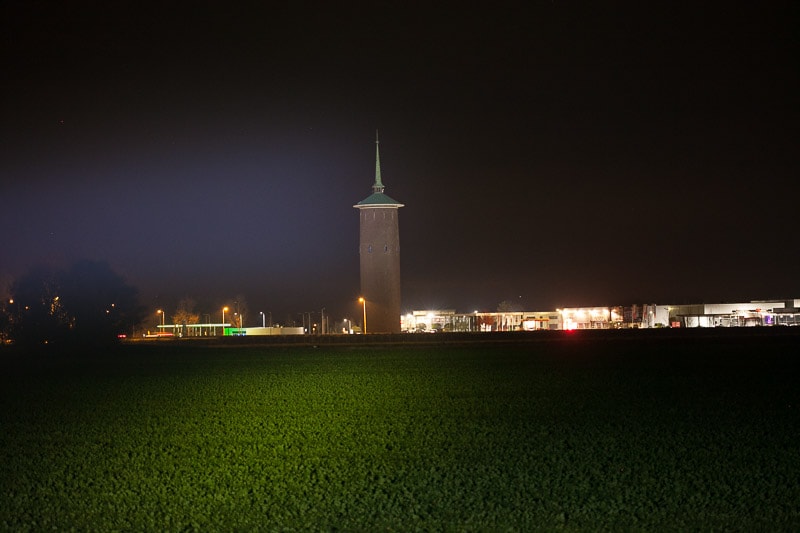
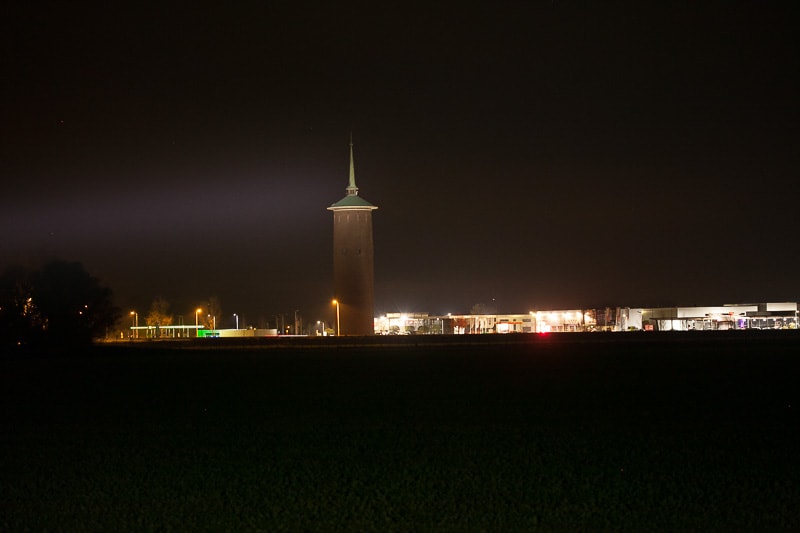
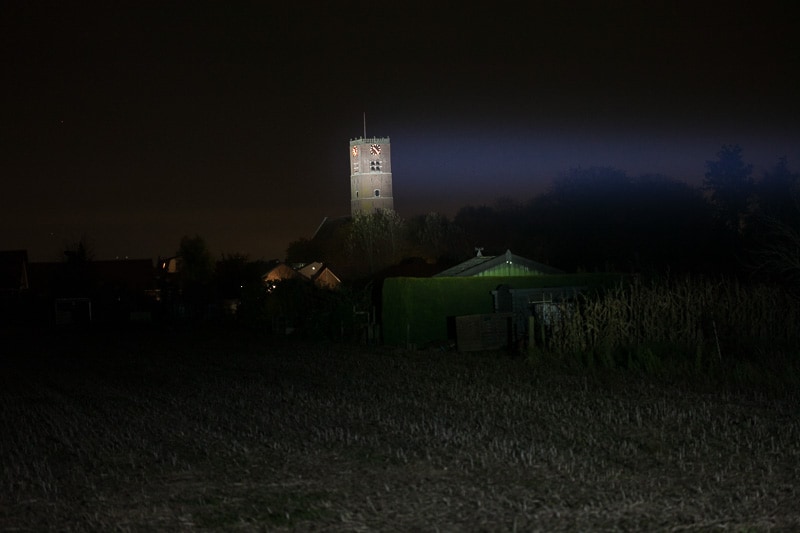
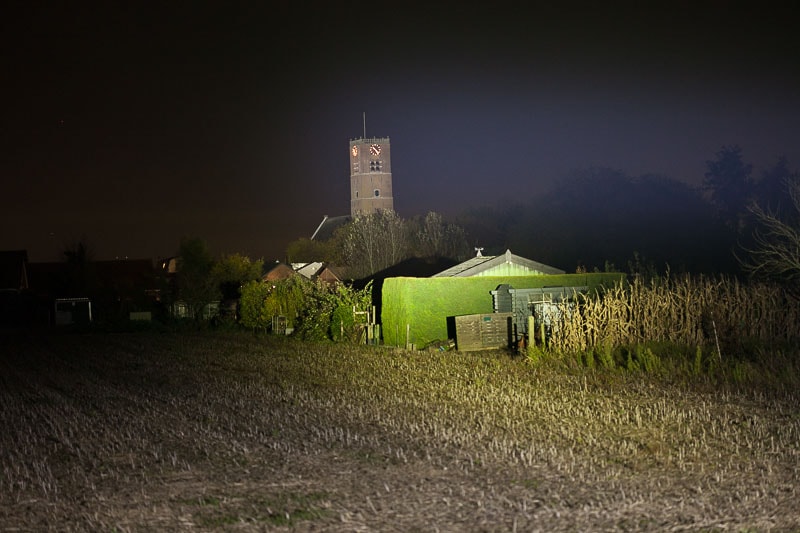
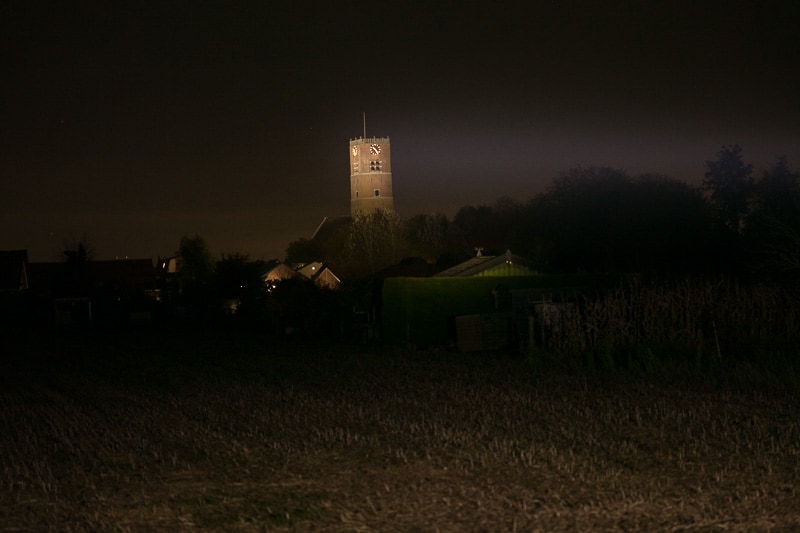
Disclaimer: The flashlight was provided by Nitetorch for review.
Final Verdict
Pros
- Extremely far-reaching LED flashlight
- Great emitter choice
- Great output throughout the total runtime!
- Includes a handle
- Eco mode is great for extended runtime. But I guess people would like to use the highest setting most of the time.
Cons
- Little front-heavy
Explanation on star ratings:
1: Avoid: my phone flashlight would be a better choice – 2: Poor: significant defect or issues; almost unusable – 3: Average: some defects or issues; but still usable 4: Good: recommended (minor issues) – 5: Great: highly recommended
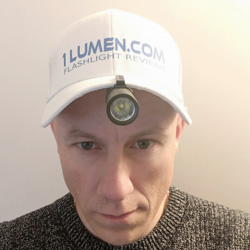
Overall Rating: 5 stars: ★★★★★
This has been one of those lights I couldn’t wait to get my hands on. After reviewing the previous 2 best throwers in the world, I just had to pick this one up. The K75 doesn’t disappoint. Acebeam took the extra step and added a carry handle that can attach to a rail or a tripod. I like the K75 a lot, and this is the farthest throwing flashlight up till this day of the review!
Acebeam K75 for sale
Unfortunately, not available at Nitetorch any longer. See our list with the best long-range flashlights for other options.
The link below points to the K75-v2 with the same specifications, just a different design.
1lumen selects and reviews products personally. We may earn affiliate commissions through our links, which help support our testing.
